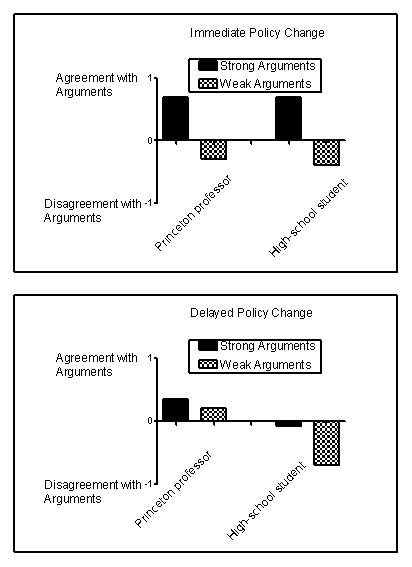Scenario II
The following scenario contains fabricated results consistent with the following study:
Petty, R. E., Cacioppo, J. T., & Goldman, R. (1981) . Personal involvement as a determinant of argument-based persuasion. Journal of Personality and Social Psychology, 41, 847-855.
Every day, consumers are exposed to scientifically based sales, marketing, and public relations strategies designed to influence purchasing decisions, change opinions, or win votes. One common sales strategy is the foot-in-the-door technique, a method that involves first making a smaller request that consumers are likely to grant and then following it by a larger request. Another common strategy is the door-in-the-face technique, which involves making an unreasonably large request that consumers will reject and then following it by a smaller request. When persuasion is necessary, it usually takes one of two forms: heuristic persuasion involves an appeal to habits or emotion, and systematic persuasion involves an appeal to facts and reason. Often, people will rely more on heuristics-simple short-cuts or "rules of thumb"-to make decisions instead of systematically weighing the evidence.
Petty and colleagues (1981) investigated some of these techniques in college students listening to arguments in favor of their college requiring an institution-level comprehensive final examination for graduation. Some students were led to believe that, if adopted, this policy would take place right away, and some were led to believe that the change would take place in a decade. In addition, some of the students were led to believe that they were listening to an argument from a Princeton professor, and others were led to believe that they were listening to an argument from a high-school student. Finally, some students heard strong arguments in favor of the policy, and some heard weak arguments. Thus, the experiment arranged six groups of students. For example, one group of students heard strong arguments from a high-school student about a far-removed policy change. Figure 13.1 shows fabricated results illustrating the major findings of this experiment.
Figure 13.1 
-(Scenario II) Which is an example of systematic persuasion?
Definitions:
Voting
The act of formally expressing one's choice or opinion in an election or decision-making process.
1860
The year notable for the election of Abraham Lincoln as President of the United States, leading up to the Civil War.
Era Of Good Feelings
Contemporary characterization of the administration of popular Republican president James Monroe, 1817–1825.
American Politics
The set of activities associated with the governance of the United States of America, including the creation and implementation of public policy, conducted both within government institutions and via political campaigns.
Q1: Aerobic exercise is a causal factor in
Q10: Richard is the executive chef at an
Q20: Jill has an abrasion on the cornea
Q38: Differences in personality are best revealed during
Q54: Meditation appears to have positive psychological effects,
Q55: People who experience burnout from their jobs
Q55: The average risk for developing schizophrenia is
Q82: A manic episode must last at least
Q87: Who is at greatest risk for burnout?<br>A)a
Q165: The tendency for people to see what